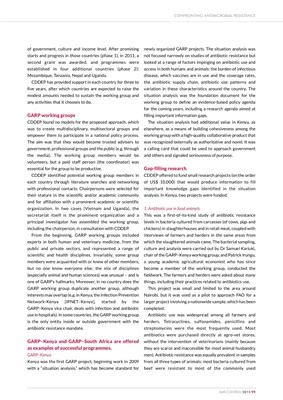
of government, culture and income level. After promising
starts and progress in those countries (phase 1), in 2011, a
second grant was awarded, and programmes were
established in four additional countries (phase 2):
Mozambique, Tanzania, Nepal and Uganda.
CDDEP has provided support in each country for three to
five years, after which countries are expected to raise the
modest amounts needed to sustain the working group and
any activities that it chooses to do.
GARP working groups
CDDEP found no models for the proposed approach, which
was to create multidisciplinary, multisectoral groups and
empower them to participate in a national policy process.
The aim was that they would become trusted advisers to
government, professional groups and the public (e.g. through
the media). The working group members would be
volunteers, but a paid staff person (the coordinator) was
essential for the group to be productive.
CDDEP identified potential working group members in
each country through literature searches and networking
with professional contacts. Chairpersons were selected for
their stature in the scientific and/or academic community
and for affiliation with a prominent academic or scientific
organization. In two cases (Vietnam and Uganda), the
secretariat itself is the prominent organization and a
principal investigator has assembled the working group,
including the chairperson, in consultation with CDDEP.
From the beginning, GARP working groups included
experts in both human and veterinary medicine, from the
public and private sectors, and represented a range of
scientific and health disciplines. Invariably, some group
members were acquainted with or knew of other members,
but no one knew everyone else; the mix of disciplines
(especially animal and human sciences) was unusual - and is
one of GARP's hallmarks. Moreover, in no country does the
GARP working group duplicate another group, although
interests may overlap (e.g. in Kenya, the Infection Prevention
Network-Kenya [IPNET-Kenya], started by the
GARP-Kenya vice chair, deals with infection and antibiotic
use in hospitals). In some countries, the GARP working group
is the only entity inside or outside government with the
antibiotic resistance mandate.
GARP-Kenya and GARP-South Africa are offered
as examples of successful programmes.
GARP-Kenya
Kenya was the first GARP project, beginning work in 2009
with a "situation analysis," which has become standard for
newly organized GARP projects. The situation analysis was
not focused narrowly on studies of antibiotic resistance but
looked at a range of factors impinging on antibiotic use and
access in both humans and animals: the burden of infectious
disease, which vaccines are in use and the coverage rates,
the antibiotic supply chain, antibiotic use patterns and
variation in these characteristics around the country. The
situation analysis was the foundation document for the
working group to define an evidence-based policy agenda
for the coming years, including a research agenda aimed at
filling important information gaps.
The situation analysis had additional value in Kenya, as
elsewhere, as a means of building cohesiveness among the
working group with a high-quality collaborative product that
was recognized externally as authoritative and novel. It was
a calling card that could be used to approach government
and others and signaled seriousness of purpose.
Gap-filling research
CDDEP offered to fund small research projects (on the order
of US$ 10,000) that would produce information to fill
important knowledge gaps identified in the situation
analysis. In Kenya, two projects were funded.
1. Antibiotic use in food animals
This was a first-of-its-kind study of antibiotic resistance
levels in bacteria cultured from carcasses (of cows, pigs and
chickens) in slaughterhouses and in retail meat, coupled with
interviews of farmers and herders in the same areas from
which the slaughtered animals came. The bacterial sampling,
culture and analysis were carried out by Dr Samuel Kariuki,
chair of the GARP-Kenya working group, and Patrick Irungu,
a young academic agricultural economist who has since
become a member of the working group, conducted the
fieldwork. The farmers and herders were asked about many
things, including their practices related to antibiotics use.
This project was small and limited to the area around
Nairobi, but it was used as a pilot to approach FAO for a
larger project involving a nationwide sample, which has been
completed.
Antibiotic use was widespread among all farmers and
herders. Tetracyclines, sulfonamides, penicillins and
streptomycins were the most frequently used. Most
antibiotics were purchased directly at agro-vet stores,
without the intervention of veterinarians (mainly because
they are scarce and inaccessible for most animal husbandry
men). Antibiotic resistance was equally prevalent in samples
from all three types of animals: most bacteria cultured from
beef were resistant to most of the commonly used
CONFRONTING ANTIMICROBIAL RESISTANCE
AMR CONTROL 2015 99